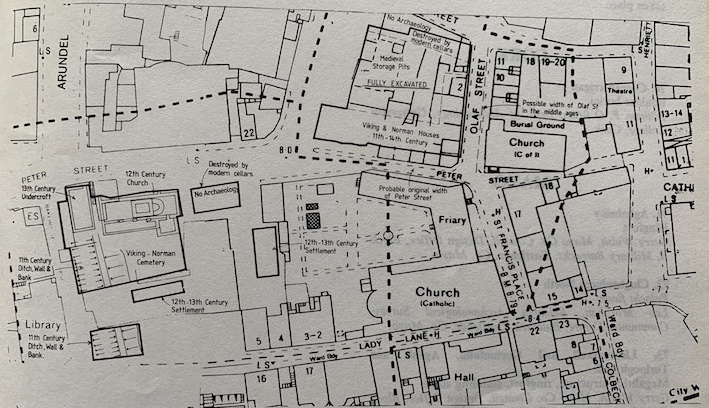County: Waterford Site name: WATERFORD: Bakehouse Lane, Custom House Ward
Sites and Monuments Record No.: N/A Licence number: —
Author: Alan Hayden
Site type: Historic town
Period/Dating: Multi-period
ITM: E 660637m, N 612352m
Latitude, Longitude (decimal degrees): 52.259537, -7.111766
This site was one of four excavated within the known medieval boundaries of Waterford, under the supervision of Maurice F. Hurley, City Archaeologist, prior to the proposed redevelopment of Waterford city centre. This site was previously excavated in 1987 as well.
Viking town defences
A further 12m-length of the Viking town defences was fully excavated. A ditch, up to 3m deep and 8m wide, had a bank up to 6m wide on its inner side. The bank was revetted by a substantial and well built stone wall, 1.8m wide and surviving up to 1.5m in height.
Dendrochronological determinations from timbers in the base of the ditch yielded dates centering on AD 1070-1080. A timber uncovered in the section of the ditch excavated in 1987 yielded an identical date. The ditch was back filled in the 12th century and a deposit of organic debris, c.2m deep, had accumulated. This was exceptionally rich in finds of all types. The very well preserved remains of three wattle buildings were uncovered on top of this.
At a higher level, a much disturbed series of ovens and ash dumps dating from the 13th-17th centuries occurred.
Viking, Medieval and later settlement and graveyards
In the area inside the town defences, a Viking house and associated settlement were uncovered.
In the 11th/12th century the northern part of this area was incorporated into the graveyard associated with St. Peter's Church. The graveyard was delineated by a wooden fence and contained a dense concentration of burials, many in stone lintel graves.
In the later 13th/early 14th century the graveyard was further extended to incorporate the obsolete defensive bank.
The graveyard remained in use until the 17th century. In all, 600 human skeletons were recovered. Remains of wooden and stone buildings relating to St Peter's Church and dating from the 13th to the 17th century occurred in the part of the graveyard closest to the church.
A series of 17th-century and later secular buildings, including a parochial hall, overlay all these features.

City Engineer's Dept., The Mall, Waterford